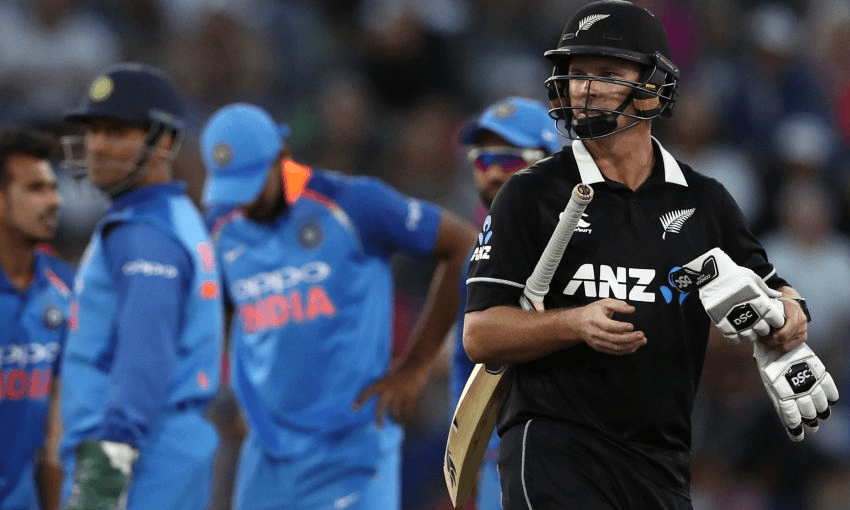On every occasion that the Black Caps have come up against a top quality opponent this home season, they’ve lost badly, and lost the same way every time. Is it time for a change of plan?
To win an ODI game of cricket, you need to put some runs on the board. That’s a crushingly self-evident statement of course, but what it obscures is that there are plenty of different strategies with which a team can push totals to 300 and beyond.
Right now, the Black Caps seem totally unable to do that. Sure, they’re playing against a fantastic Indian side, with a much improved seam bowling attack, and some of the best spinners in the world. But they’re also playing on small grounds with fast outfields, and relatively flat pitches. At a ground like McLean Park in Napier, you should be able to score 350 and still lose. In the first game of the series, the Black Caps scored 157.
There are a few strategies being used internationally which the Black Caps seem caught between. Right now, their game-plan bears most resemblance to that used by England. Once known for stodgy plodders, England now consistently win ODI matches by going hard as hell all the way through, and relying on having the batting depth to make it to 50 overs. Their ODI bowling isn’t that great, but when you’ve got a team full of dashers, that doesn’t really matter. In the last two years, they’ve been nigh-on unstoppable, winning every series except the Champions Trophy, and a one-off ODI against Scotland.
The strategy being used by the Black Caps has elements of this, but doesn’t fully commit to it. Basically, the Black Caps’ version of it involves having bowling all-rounders at 7, 8 and 9, a super-talented middle order, and two openers who are meant to try and smash the new ball. The only problem is that so far in this series, none of the elements have worked.
Since the start of 2018, the opening partnership has just been flat out mediocre. It has pretty much always featured Colin Munro and Martin Guptill, except for three games involving George Worker. Both Guptill and Munro are high risk, high reward players. But the rewards have been few and far between – across 19 innings, the opening partnership averages just 21, and at a run rate of 5.9. Breaking down the list into individual innings, that run rate rises a lot when some actual runs are scored. But the last ODI opening partnership of any note happened more than a year ago – 52 against Pakistan in Wellington.
That’s leaving way too much pressure on the likes of Kane Williamson, Ross Taylor, Tom Latham and Henry Nicholls to score big runs, without giving them any sort of platform or protection to build from. The contrast with India is striking. Shikhar Dhawan and Rohit Sharma have an average together of 44 over that same period, and while both score quickly, neither would be considered sloggers. It’s that sort of platform which has allowed India to play to their best strength: having Virat Kohli bat deep with whichever opener survives. Some figures that underline that approach: in the same period, the Kohli/Sharma partnership averages 104 in 9 innings, and the Kohli/Dhawan partnership averages 80 in 11 innings. From there, they can throw to MS Dhoni, who despite becoming less effective with age, remains probably the most accomplished finisher in ODI cricket.
What New Zealand are going for is an extension of the Brendon McCullum era, of playing ultra-attacking cricket that can blast theoretically stronger opponents off the field. But with the loss of McCullum himself (and to a much lesser degree, Luke Ronchi and Corey Anderson) the team no longer has the players capable of carrying that strategy out.
However, they do have the players for a different kind of strategy. With more emphasis on conserving wickets at the top of the order, platforms could be set which then allowed for explosive finishes. It’s not beyond the realm of possibility any more to score 200 off the last 20 overs, provided there are wickets in hand. That allows for huge totals to be set or chased down. Munro, Jimmy Neesham or Colin de Grandhomme would all be useful options in these sorts of roles, and Nicholls and Latham have developed the ability to score singles off pretty much every ball, which gives hitters room to move. Currently, the lower order isn’t able to make a difference, because they’re being left with far too much to do.
It’s possible that it will all come right for the batting lineup at the back end of this series. But a single good knock from one of the openers wouldn’t change the structural failings of the approach, and with the World Cup only a few months away now, that failing is likely to come into sharp relief.
If nothing else, the last two dead rubber ODIs against India would be a great chance to try a new approach. Perhaps Latham should be given another run at the top. Even though last time he was tried there it didn’t work out, he’s clearly improved significantly as a batsman since. And it would be great to see Munro come to the wicket in the 40th over, with the mission of trying to hit the old ball out of the ground. If New Zealand is going to go deep in the World Cup, at some stage we’ll almost certainly have to beat India. And the current plan just isn’t working.

